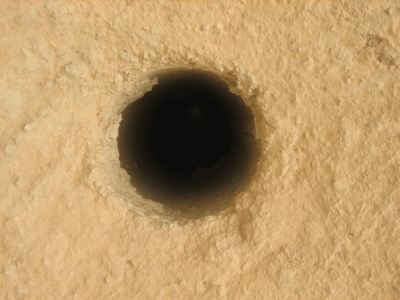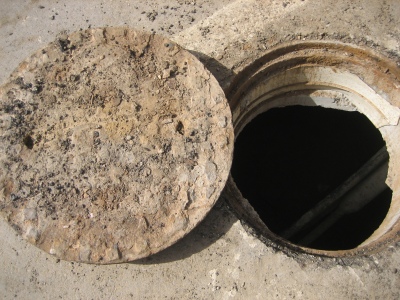The round thing thing.
June 18, 2009
I have this thing about round things. Circular, flat, usually metal things. Think about it – the circular shape is not very common in nature – I mean really round like the sun (which you’re not supposed to look at anyway) or a really full moon. Down on earth, if you see a round thing, it’s almost always man made. As the daughter of archaeologists, sometimes we’d walk farm fields in Kansas and Missouri looking for sites. I blame that activity for the fact that I continue to look down and pick up stuff I see on the ground. In the last couple of decades the things I’ve focused on have been round – usually metal things – like washers, nuts, small bits of detritus of construction and cars that have been broken off and abandoned. Things like this:
In particular, I collect metal round things, and over the years this habit has led to some interesting adventures and some wonderful gifts from people. And it’s given a focus to a tendency to wander around looking at the ground. Since this blog is now about what I’m doing in Erbil, here’s some I’ve found lately. (And this is just what’s not on the server since it’s still down.)

Water tanks on the roof.
I’m starting a series on these water tanks. You’ll see more of them later….

Wire calligraphy found on the roof.
This relates to another collection I’ll talk about later that lives in the house at Gordion, in Turkey. More about that in a couple of weeks when I’m there. But in the meantime, let me say I’m unsure what language this calligraphy is in because Arabic, Kurdish, Assyrian, Turkish, English, and a little bit of German are all spoken regularly in my house. I’m the only one who only speaks one of them.

A round thing hole in my roof.
I don’t know why it’s there, but if I didn’t go around looking for round things, I never would have noticed it.
Ready to go again.
June 17, 2009
I’ve been slow to post on my blog as I’ve adjusted to my new life working as an “ex-pat” for an NGO in Erbil. Even describing myself in a new way has taken a bit of getting used to. But after almost one month here, life is starting to become familiar again, I’m figuring this place out and even getting some daily habits. So, I’m ready to start up blogging again.
Here’s a photo of something I’ve seen recently because blogs are boring without photos.

The man hole I didn't fall into and it's round thing cover.
This is the second time I’ve moved abroad (the first was for conservation school at the Institute of Archaeology in London). The experiences, of course, are totally different – but one thing that is making adjustment particularly easy this time is the social media programs I’m hooked up on (or is that “with” or “to”). I use email of course, and am subscribed to several listservs. I also Twitter and Facebook regularly. I chat via Google. I’m in the midst of figuring out Flickr. Oh yeah, and Skype, I love Skype. I am in touch with friends, family and colleagues constantly here. No time to get lonely.
The new social media and web 2.0 are a big area of discussion in conservation right now following the recent American Institute for Conservation meetings. If you want to find out more about how professionals are using them, here are a couple of recent posts that should lead you into the interactions (and what’s good about it).
Most recently Kevin Driedger’s Library Preservation blog – which posted a nicely done slideshow about Socially Networked Preservation.
I particularly watch Dan Cull’s weblog for updates on what’s going on. He’s also got incredible lists of links to other resources. (I can’t figure out how to fix the formatting here, so apologies for the messed up paragraphs.)
There are lots more, Richard McCoy’s work in several media and Ellen Carrlee’s blog are two I particularly like for finding out what’s going on, but I’m getting bored attaching links, so you’ll have to search them out through the links above (which is really the point).
To add to the discussion I want to give my perspective as a western conservator working in a non-western country that is expanding and building (or rebuilding) it’s infrastructure – to give a little reality to the very positive things that are being and can be done with it.
First the negative (and many are obvious). But if you are trying to hook up conservators with the international conservation community, infrastructure problems make it harder:
- If you don’t have power, you don’t have access. Unless you are lucky enough to live somewhere with a generator (as I am) you can’t get on-line regularly. Just yesterday I heard a story of a university student trying to write his thesis who hasn’t been able to get it done because he doesn’t have enough power each day.
- If you don’t have high-speed access, it’s almost as bad as not being on-line, or maybe even worse. Waiting for something to load, or waiting for the buffering of some great powerpoint you want to see, can be maddening.
- When an online resource goes away, you’re stuck. I consciously didn’t bring my AIC, IIC and other membership guides knowing I could track people down through CoOL. If CoOL goes away (and I’m sure it won’t because good people won’t let it) I’m stuck (or at least needing to spend more time bugging colleagues for contact info.
- And of course there’s the obvious. You have to have access to a computer, that’s hooked up to the internet.
Next the positive beyond what’s been said in other blogs:
- I am finding amazing resources for training on-line that I didn’t know about before. ICCROM and the Getty Institute have put whole course curricula and books on-line as .pdfs. Since our original budget didn’t include money for books – these sources are invaluable, and will be invaluable for the labs around Iraq who have minimal resources. There’s lots more I’ll post later as I put together information for the students.
- Twitter, even better than listservs like OSG-L and the Conservation DistList gets you immediate feedback for questions. I came from a nice big lab, with wonderful colleagues and students. I’m on my own here. But I still have people I can ask those quick questions of – like last week’s “what should you spec the RH to be if the average outside is 10%”? (And if you are my NMAI colleagues reading this, get on Twitter so I can ask you!).
- People’s blogs lead me into resources I wouldn’t find myself. Thanks to everyone in the conservation/preservation field who is blogging – you help more than you know.
That’s all I’ve got right now. Let me leave you with one more image because I am living in an beautiful place and want more people to know about it.

Yakima Fresh Red Delicious apple from Washington State, USA, sitting on my table in Erbil, Iraq.
Sorry, all the beautiful images are on the server, which is down. But at least this fuzzy image shows you that even over here, I’m still hooked up.



